Dungeons & Dragons is revealing a first look at the cover to its upcoming Dungeons & Dragons cookbook. ComicBook.com can exclusively reveal a first look at the cover for Heroes’ Feast Flavors of the Multiverse: An Official D&D Cookbook, which will be released in November by Penguin Random House. The new cookbook is written by Kyle Newman, Jon Peterson, Michael Witwer, and Sam Witwer and features over 70 recipes inspired by the Dungeons & Dragons multiverse. Additionally, ComicBook.com was able to check out a few of the recipes from the new cookbook and spoke with the authors via emails about the prevalence of food in fantasy and how they researched the foods that would go into the new book. You can get your first glimpse at the cover below and check out our full interview afterwards:
Videos by ComicBook.com

The fantasy genre embraces food in a way that most genres don’t. Why is food embedded into the fabric of fantasy?
Worldbuilding demands verisimilitude and fantasy is no exception. Details are the building blocks of “reality.” So, no matter how fantastic the setting, no matter how extraordinary the culture, for it to be believable it has to be grounded in a particular set of rules and details, like food. D&D players crave immersion — and food is a wonderful layer to help steep these worlds in tradition and truth.
D&D, in particular, was born out of a gaming culture that prized realistic simulation, and the notion of needing food was inherent in the earliest versions of the game, usually represented in the simple tracking of weekly rations. As the game developed through different communities, food became a key part of the game’s narrative experience. In many of the early modules, it was not uncommon for taverns to have long lists of food and drink from which adventurers could choose. Why so many options for an element of realism that could just as simply check the box? Perhaps it’s because the game’s designers realized that food could provide new avenues for the narrative experience—that the unexpected, memorable, and hilarious moments of any given D&D session are as likely to come up over an in-game tankard of Neverwinter Nectar as they are while battling monsters.
D&D also has one foot in fantasy fiction, and whether you experience it off the page or off the screen, you’re going to read about food. Whether it’s trail cooking for hobbits who have ventured out of their comfort zone, or a banquet feast for the wedding of a doomed couple, you can’t do fantasy without food.
Perhaps that’s why so many Dungeons & Dragons campaigns have their kick-off sessions in Taverns… Essentially, restaurants.
How did you research Flavors of the Multiverse? With so many settings and books to choose from, did you have a specific starting point when you started to choose inspirations and fantasy dishes for this cookbook?
For the first Heroes’ Feast, we conducted extensive research and generated a huge list of dishes and themes from the game’s nearly 50-year history. For Flavors of the Multiverse, we began right where we left off with even more research, diving deeper into new fifth edition campaigns, settings and novels, as well as looking back at the trove of materials from past editions. The team discussed various culinary themes we wanted to explore in a fantasy setting and how we could apply those ideas to D&D in a grounded way. Fifth edition has really expanded since our first book and the narrative framework also allowed us to explore new worlds and flavors.
One thing we felt strongly about for this book was to not simply retread all the same ground. We took all the things we liked best about the first book and went bigger—grander sets (we even rented a castle for the photo shoot!), a wider range of flavors and ingredients, new locales, more illustrations, etc.
We also added a fun narrative element–some food-loving characters we plucked straight from the cover of the first Heroes’ Feast, who we follow on a madcap adventure through the multiverse, which provides the locational basis for the dishes we feature. That helped to keep the recipe list under control: once we knew where the characters were going, and what adventures they’d have there, we knew where to look for the right dishes to pair with their story. D&D’s urban settings run the gamut from street food to fine dining, so our party gets to experience a bit of both and everything in the middle.

Is there any difference between designing a recipe for a D&D cookbook and a normal cookbook?
A Dungeons & Dragons cookbook demands a twist. Each recipe requires an intersecting idea to help justify its inclusion and to help elevate a seemingly familiar dish. Imperative for us was the lore, additional context and the story behind the meal and the setting from which it originates. What makes each entry fascinating is the how and why of it.
Another factor is feasibility. While the worlds of D&D have many similarities to our
own, many of its dishes can’t be prepared without powerful spells, magical items, and access to an array of mystical ingredients. In consideration of this, our overall methodology in creating this recipe collection was to find every notable dish in the D&D multiverse; curate and modify it for feasibility and flavor; and present it here in a way that even a 1st level chef might be able to make it for game night.
Was there a recipe that you were worried about including in the book, either because it was challenging or had a unique taste palette?
The first Heroes’ Feast came out during the pandemic and the ability to source certain ingredients was a key factor in determining the final recipe list. For Flavors of the Multiverse we are excited about including a broader range of ingredients, such as venison and even crickets, which we weren’t able to put in the first book. The better availability of ingredients paired with the expanded settings of fifth edition at our disposal allowed a broader palette.

Did you have a favorite recipe in this book?
There are so many good ones! A few standouts are the Bacon-Wrapped Smoked Mussels from Sigil; the Yawning Portal’s Chopforest salad; the Steak of the Deep from Lake Bral (Rock of Bral); and the Chickpea and Spicy Sausage Soup. For dessert, there’s the Silverfruit Pie, Krynn’s Kendermore Cobbler and Vada’s Vanilla Buns from the Radiant Citadel. As a refreshing drink, the Purple Grapemash No. 3 or the Ray of Frost is definitely worth a look.
How often do these dishes get served at your D&D home game?
Kyle: It’s not uncommon for me to cook for my game group. It was obviously challenging during the pandemic but now that people are getting back together at the table it’s the perfect time to share a meal. I also prepare these recipes on non-game days for my friends and family. There are so many dishes that have become staples at the dinner table in my house and that was our goal as authors — to create a very usable cookbook, mostly familiar but always with an elevated, thematic twist. Like D&D you need to feel like you are going on an adventure, even if it’s just at the table!
Authors’ Note: A few of the recipes from Flavors of the Multiverse will feature in the upcoming Heroes’ Feast Cooking Show produced by eOne for those hungry for a sneak peak of what’s on offer in the new book.








